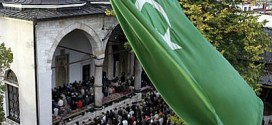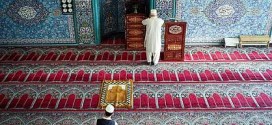The Fatimids and the Institutionalization of Sunni-Shi’ah Conflicts Assoc. Prof. Dr. Spahic Omer Kulliyyah of Architecture and Environmental Design International Islamic University Malaysia E-mail: spahico@yahoo.com
The Mosque of al-Hakim.
The Fatimids, it could be thus inferred, were among the first in Islamic civilization who used the power of writing signs on buildings in order to advance and publicize their ideological struggle. The earliest Muslim example of using buildings and building decoration systems as a means for promoting a spiritual mission and cause could be traced back to the creation of the Dome of the Rock in Jerusalem which was initially completed in 72 AH /691 CE at the order of the Umayyad caliph ‘Abd al-Malik b. Marwan (d. 86 AH /705 CE). Via the ways the building and its decorative styles and strategies were perceived, planned and executed, the local Jewish and Christian population was mainly targeted. However, the way the Fatimids made recourse to utilizing the power of letters and symbols on buildings for advertizing and promoting their struggle and cause was like what nobody has ever seen before. The relatively small mosque of al-Aqmar (the Moonlit, or Gray mosque) in Cairo founded by Ma’mun al-Bata’ihi (d. 519 AH /1125 CE), vizier of the caliph-Imam al-Amir Biahkamillah (d. 525 AH /1130 CE) in 519 AH /1125 CE, is an ideal extant illustration of this Fatimid tradition. A striking feature of the building is the decoration of its projecting portal and the entire front façade which faces the major al-Mu’izz Li-Dinillah street which, in turn, forms the main axis of the city of Cairo stretching from Bab (Gate) al-Zuwayla in the south to Bab (Gate) al-Futuh in the north, and virtually dividing the city into two corresponding parts. The hood of each niche on the mosque’s façade is composed of radiating flutes with a central medallion. The following Qur’anic words are inscribed in a concentric circle medallion over the imposing entrance portal: “…Allah intends only to remove from you the impurity (of sin), O people of the (Prophet’s) household, and to purify you with (extensive) purification.” (Al-Ahzab, 33). In the centre of that medallion are the names of Muhammad and ‘Ali. Inside another two smaller medallions at right and left wings there is the name of ‘Ali encircled with the name of Muhammad written 5 times. Moreover, at each of the mosque’s two corners which flank the mosque’s front wall, there are three small niches, one above the other two, wherein the following Qur’anic words: “Indeed, Allah is with (the top niche) those who fear Him (the bottom right niche) and those who are doers of good (the bottom left niche).” (Al-Nahl, 128), are engraved. On both sides of the top niche there are discs the right one having the name of Muhammad and the left one of ‘Ali. Hence, the top portion can be also read as: “Indeed, Allah is with Muhammad and ‘Ali”. In the whole of the mosque, in addition, there are 25 elaborately decorated stucco window grills with the names of Muhammad and ‘Ali etched inside two small discs placed almost in the middle on the right and left of each grill. Inside the right disk is the name of Muhammad and in the left one the name of ‘Ali. Of those 25 intricately embellished stucco window grills, 23 face the interior of the mosque and two the exterior. The latter is part of the rich decorative style and language of the mosque’s front facade. And finally, above the praying niche or mihrab of the mosque, tributes for the Fatimid (Isma’ili) Imams and caliphs are evidenced. That said, ornamental deep and shallow niches, as well as flat arches, with their hoods composed of radiating flutes with or without circle medallions being placed either in the center or independently next to those niches and arches — irrespective of whether there are inscriptions or not in the midpoints of those medallions – denote, perhaps, the most recognizable features of the Fatimid art and architecture. To Irene A. Bierman, circle disk medallions are “immediately recognizable by Isma’ilis as the sign of Isma’ilism.” What is more, the hood composed of radiating flutes, or the ribbed shell hood, with its pierced medallion in the mosque of al-Aqmar was the prototype of all the later cusped, ribbed, blind, keel-arch decoration which remains somewhat vogue in Cairo’s buildings. As a matter of fact, both fluted niche hoods and a brand of medallions as simple and inelaborate decorative media existed in Egypt even before the Fatimids, as evidenced by the way the mosque of Ahmad b. Tulun (d. 271 AH / 884 CE) had been decorated. However, the Fatimids perfected those media and made sure that ever after they remained integral to the vocabulary of diverse Islamic art and architecture in Egypt and beyond. Without a doubt, elaborately decorating the front facade of the al-Aqmar mosque with intriguing inscriptions suggestive of Shi’ism, plus setting the façade at a different angle from the rest of the mosque to ensure that it faced onto, and was parallel with, the main al-Mu’izz Li-Dinillah street, radiated certain messages to both Shi’is and Sunnis. To the former, it was a message of intrinsic unanimity, espousal, endorsement and even craved-for revival, bearing in mind that at the time of the mosque’s construction, the Fatimid power was rapidly on the wane and was marred by the loss of some important territories to the Crusaders, as well as by the escalating internal schism. The founder of the mosque, the vizier Ma’mun al-Bata’ihi, therefore, was known as the restorer of “Shi’i orthodoxy”. To Sunnis, on the other hand, the front façade of the mosque and the way it was positioned and adorned was an oblique and, at the same time, unaggressive message that insinuated Sunni religious inferiority, inadequacy, and an urge for soul searching as to who exactly was right and who was wrong. Hence, unlike the fanatical initiatives of al-Hakim, which caused widespread resentment and hostilities, and so, their speedy rescinding, the more amiable ones, such as the ornamental styles and themes of the mosque of al-Aqmar, remained undisturbed and operative. Aside from being planned to face and be parallel to the main city’s street and its artery, so as to convey the intended messages to the meant audiences, it likewise was not by chance that the al-Aqmar mosque for the same socio-political and spiritual purposes was located near the site which was occupied by two great Fatimid palaces. As a result, the whole area, and the part of the al-Mu’izz Li-Dinillah street, which adjoined the palaces and stood in the vicinity of the mosque, were always bustling with life. There rarely ever were anywhere in the city more people, shops, institutions and generally life activities than in the said areas. This applied not only to the Fatimid era, but also to the subsequent Ayyubid and Mamluki eras, as hinted by Ibn Battuta (d. 779 AH /1377 CE) who visited the city of Cairo in 727 AH / 1326 CE. Moreover, in the mosque of al-Hakim, there is a huge medallion with the names of Muhammad and ‘Ali etched in its center. The medallion serves as an ornament and is positioned just above the mosque’s praying niche (mihrab). Bearing in mind the time difference between the mosque of al-Hakim and the al-Aqmar mosque, and between the reigns and years of the people responsible for their construction, it seems as though the medallion functioned as a precursor for what later emerged with slight design and content variations as a distinct Fatimid trend. On the same note, inside the mausoleum of Sayyidah Ruqayyah, a daughter of ‘Ali b. Abi Talib whose mother, however, was not Fatimah but another wife of ‘Ali, in the center of the hood of a praying niche there is a medallion in the center of which the name of ‘Ali is carved. The name is framed with the name of Muhammad etched in an interlocking fashion six times. What’s more, just above the niche, the following Qur’anic words with reference to the Prophet’s household are inscribed: “Allah intends only to remove from you the impurity (of sin), O people of the (Prophet’s) household.” (Al-Ahzab, 33) The mausoleum was built by the Fatimids in 528 AH / 1133 CE. That was a facet of their conspicuous culture of architecturally glorifying some of the deceased members of ahl al-bayt, genuinely or otherwise. Parenthetically, it was the Shi’ah at large who contributed one of the greater shares to the evolution of funerary architecture, or the architecture of dead, within the fold of Islamic culture and civilization. As soon as they arrived in Egypt, it seems that the Fatimids went on an offensive with regard to using and manipulating the great potential of signs, symbols and canon writing. Thus, just above the Fatimid Cairo’s Bab (Gate) al-Nasr on a panel, and on the city’s wall adjoining the Bab (Gate) al-Futuh in a band, there are identical inscriptions which read as follows: “In the Name of Allah, the most Compassionate, the most Merciful; there is no god but Allah, the only One without a partner; Muhammad is Allah’s messenger; ‘Ali is Allah’s wali (friend and one vested with the authority of God).” We have already mentioned that the Cairo walls and its gates were of the early structures erected in Egypt by Jawhar al-Siqili, the conqueror of the place and the builder of Cairo. Both inscriptions faced the outside of the city. That means that every visitor to it was first and foremost welcomed by, and reminded of, their meanings, significance and role in shaping the Fatimid society, mind and culture. Correspondingly, the mosque of Ahmad b. Tulun, which had been built exactly 94 years before the arrival of the Fatimids in Egypt, has a stucco panel with an elaborate arabesque whose highlight are the words: “There is no god but Allah; Muhammad is Allah’s messenger; ‘Ali is Allah’s wali or friend”. But to an insightful observer, such decorative panel is an alien addition to the mosque and its extremely modest and straightforward decorative style, especially in terms of the panel’s placement, content and design. The panel rather looks like an adopted and directly transported element from the subsequent decoration and embellishment realms of the mosques of al-Hakim, al-Azhar, al-Aqmar and indeed of all the other Fatimid buildings, in particular those of the later periods. At any rate, it is believed that the decorative panel was part of what is today called “the Fatimid mihrab or praying niche” inside the mosque of Ahmad b. Tulun. The Fatimid mihrab was one of a few mihrabs that existed inside the mosque. This additionally boosts an argument that the mosque of Ahmad b. Tulun had somewhat a special place in the Fatimid psyche, as a result of which much of the form of its colossal and massive colonnades and the spacious courtyard served as a source of inspiration for the same inside the mosque of al-Hakim. As a small digression — finally — even the Shi’ah Buyids in the Muslim East, especially in Baghdad, adopted moderately a similar approach in their own ideological confrontations with Sunnis. On the mosques, as well as on some erected posts and signboards, the standard words “Muhammad and ‘Ali are the best of people; he who is content (with that) is grateful, and he who rejects (that), is an infidel” were regularly inscribed, now and again even with gold. But this campaign’s intensity and scale were rather restricted and one-dimensional, so to speak. They were no match for those which the sophisticated Fatimid ideological promotional drive and machinery epitomized and set in motion.
 Dzemat Braunau
Dzemat Braunau


